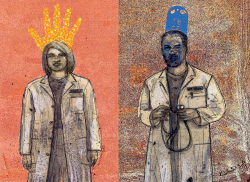
Osteopathic medicine, founded in 1874 by Andrew Still (an M.D.) took nearly a century to shed the status of holistic heresy.
And while the percentage of D.O.s among U.S. physicians has grown steadily since 1980, many would-be patients have a vague understanding, at best, of what separates a doctor of osteopathy from a doctor of allopathic medicine (M.D.).
“Osteopathic physicians are licensed to practice the full scope of medicine in all 50 states,” says Wendy Bresler, a spokeswoman for the American Association of Colleges of Osteopathic Medicine. D.O.s can specialize in the full range of medical disciplines, just like their allopathic colleagues.
How do they differ? Well, for one thing, the schooling. A common misconception about D.O.s is that they don’t receive as much schooling or as rigorous an education as M.D.s. In fact, osteopathy students are required to receive an additional 200 hours in osteopathic manipulative medicine — a concentration on the musculoskeletal system that uses the hands to diagnose and treat injury and illness — on top of studying the basic sciences.
“The education in osteopathic medicine is focused in primary care,” Bresler says. “The whole patient is considered. It’s not just about treating disease; it’s about prevention.”
But the added concentration on osteopathy is what has earned the medical science a negative connotation in certain circles, says Jeffrey Devries, M.D., vice president of medical affairs at DMC-Children’s Hospital of Michigan.
“The concern may have been, in the past, that the time spent learning the components of medicine that are strictly related to the osteopathic manipulation may have taken away time from learning some of the more traditional medical regimens,” Devries says. “I think part of it is a non-complete acceptance within the M.D. community of the value of the contribution of that kind of treatment.”
Greater understanding and acceptance may come with the current increase in osteopathic medical students, a number that the American Osteopathic Association says has been growing at a quicker pace proportionately than the number of allopathic medical students.
Nine new colleges of osteopathic medicine have been established since 2000, and today, nearly one in five U.S. medical students study at a college of osteopathic medicine.
The rise is due, in part, to the general increase in demand for primary-care doctors. “We really do believe we’re going to be coming to a physician shortage in the next few years,” says John Prescott, M.D., a representative for the Association of American Medical Colleges. “Both M.D. and D.O. programs have responded to that call.”
More and more, the two distinctions are working together, Prescott says, citing residency programs that use both types of medical students working in the same facilities.
“There’s much more overlap in their expertise than there are differences,” Devries adds. “They’re really working arm in arm — together.”
|
|
|









